CEOs and business leaders face a series of common leadership challenges on a daily basis. These range from external challenges around motivating teams and managing people and resources, to internal challenges such as managing stress and avoiding burnout.
This guide will help you to identify some of the biggest challenges faced by CEOs and managers, equipping them with the leadership skills required in order to overcome them.
Why are leadership challenges important?
Understanding – and dealing with – leadership challenges is vital for delivering management that most effectively fosters efficiency and productivity in the workforce. Great leaders offer their employees clarity of purpose and help to motivate them to perform their roles to the best of their ability.
Leadership challenges come in a variety of forms and can be broadly characterised as external and internal challenges. Making sure instructions are communicated clearly and concisely is an external challenge all leaders face, both when dealing with individuals and with teams. Leaders need to be confident to make tough decisions and keep employees motivated by nurturing their professional development.
Internal challenges faced by leaders relate to their personal disposition and how this informs the way they are seen by employees. Embodying a confident figure of authority while remaining fair-minded and humble is a difficult balancing act for managers to perform. Like all members of staff, leaders can also be prone to burnout and stress, so overcoming these difficulties is a crucial part of delivering great leadership.
The article from Deloitte, Leadership for the 21st century: The intersection of the traditional and the new, outlines the importance of performance management when developing strong leaders capable of overcoming challenges:
“Putting different performance measures in place for leaders can go a long way toward establishing a culture that supports competencies such as the ability to manage uncertainty and lead through change.”
In this guide, we’ll explore these common leadership challenges faced by managers and CEOs, and the tools and techniques you can use to overcome them.
The most common leadership challenges
While leadership challenges vary from one company to another and are influenced by the nature of the business, most leaders will face common challenges regardless of their industry.
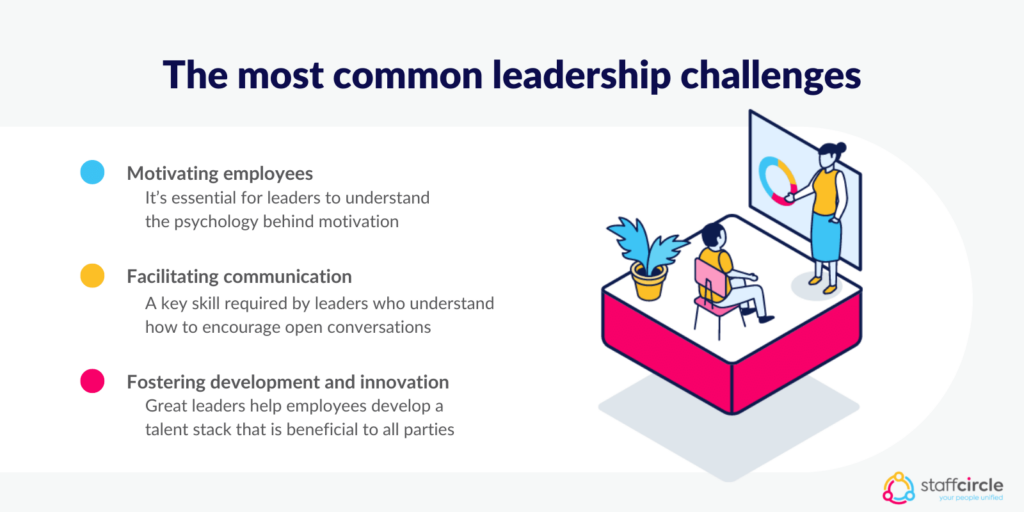
The three most common leadership challenges all leaders face are motivating employees, facilitating communication, and fostering development and innovation.
Motivating employees
Without a workforce that is motivated to deliver their best work, most businesses are destined to fail. Employees who have no investment in company goals are likely to underperform and lack the willingness to go the extra mile.
A great leader knows how to motivate employees so that they feel invested in their work and understand how they contribute to the company’s success. It’s essential for leaders to understand the psychology behind motivation, and how this ties into fostering a culture where well-being and purpose are valued.
Facilitating communication
On a practical level, great leaders establish systems that allow all employees to effectively communicate with one another, whether they are on-site office workers or remote workers and freelancers. Many successful businesses achieve this foundation by using a multi-channel communications platform to keep everyone connected.
Facilitating communication is a key skill required by leaders who understand how to encourage open conversations. A great leader is one who listens to their subordinates and values their input, encouraging an environment where open dialogue is the norm. They regularly engage with employees through one2one check-ins and informal chats, making it clear they can be approached with any concerns, feedback or new ideas.
Fostering development and innovation
Employee engagement and motivation are intrinsically linked to learning and development, and facilitating an employee’s growth is a fundamental challenge all leaders face. This also means encouraging employees to brainstorm ideas and adopt a creative approach to problem-solving.
Identifying and nurturing talent begins the moment a new hire begins their first day on the job and continues throughout their tenure at the organisation. By aligning their personal and professional development with the company’s overall strategy, great leaders help employees develop a talent stack that is beneficial to all parties.
Challenges of Communication: Challenges That Threaten Team Dynamics
Healthy and productive team dynamics require clear channels of communication. We’ve touched briefly on how business leaders can achieve this with a multi-channel communications platform, which can be used to keep each team member connected.
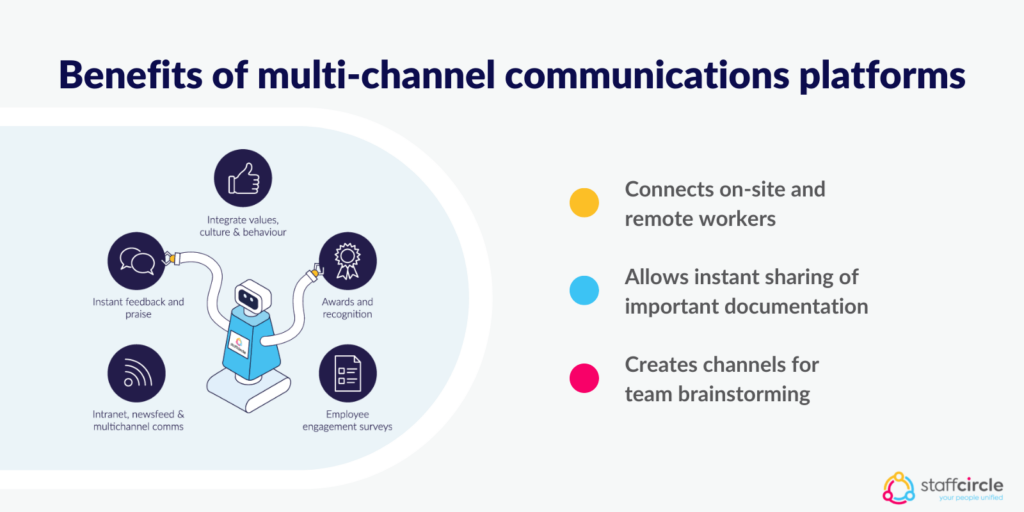
A multi-channel communications platform:
- Connects on-site and remote workers. By channelling information to desktop/laptop computers, as well as through SMS text messaging and in-app push notifications, teams with members working in different locations can stay in touch instantly.
- Allows for the instant sharing of important documentation. New policies and protocols that affect a team’s roles can be disseminated easily, with digital receipts available to make sure the information has been received and understood.
- Creates channels for team brainstorming. Performance management software allows teams to create forums to discuss projects and share new ideas. They also allow for the integration of Microsoft Teams, where dedicated channels for teams can be established to facilitate ongoing conversations.
Keep everyone on the same page
Performance management software offers powerful tools to help employees set and track objective and development-related goals. These goals can also be set at the team level, ensuring each member understands how their work relates to their colleagues.
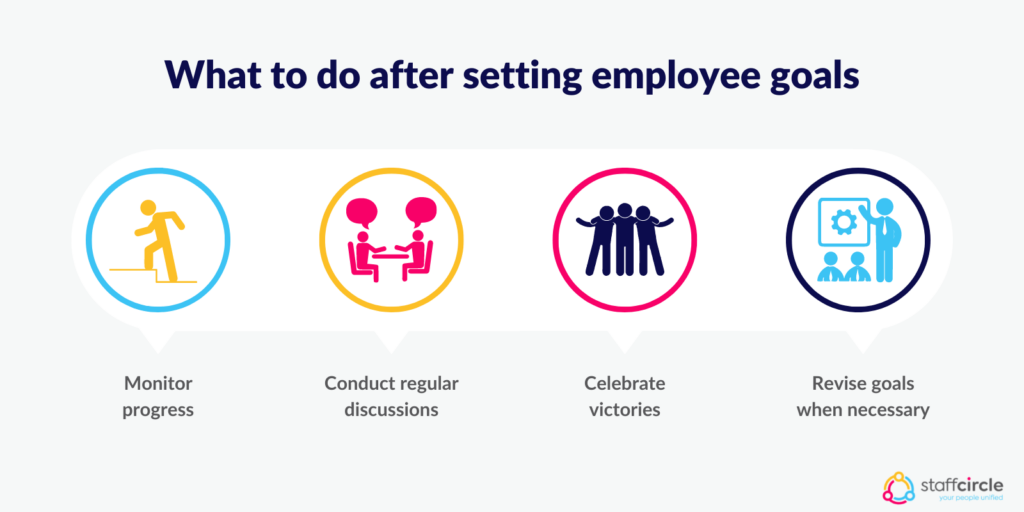
Effective leadership involves each team member in the setting of team goals to give them a greater sense of ownership of their responsibilities. Once team goals have been established and inputted into performance management software as objectives and key results (OKRs) with clear metrics to measure, leaders should then:
- Monitor progress towards these goals to make sure the individuals and team at large is on track for success
- Conduct regular discussions with the team about their progress and any challenges they are facing, while offering the necessary resources and support to overcome them
- Celebrate victories with the team when they hit their milestones, finish projects, and accomplish their goals
- Revise goals when necessary, and establish new objectives that take on board any lessons learned over the previous period of time

Challenges of skill: 5 leadership challenges that test your abilities
Business leaders and managers face a range of challenges on a daily basis, each of which needs to be tackled in order to keep individuals and teams on course to succeed in their work.
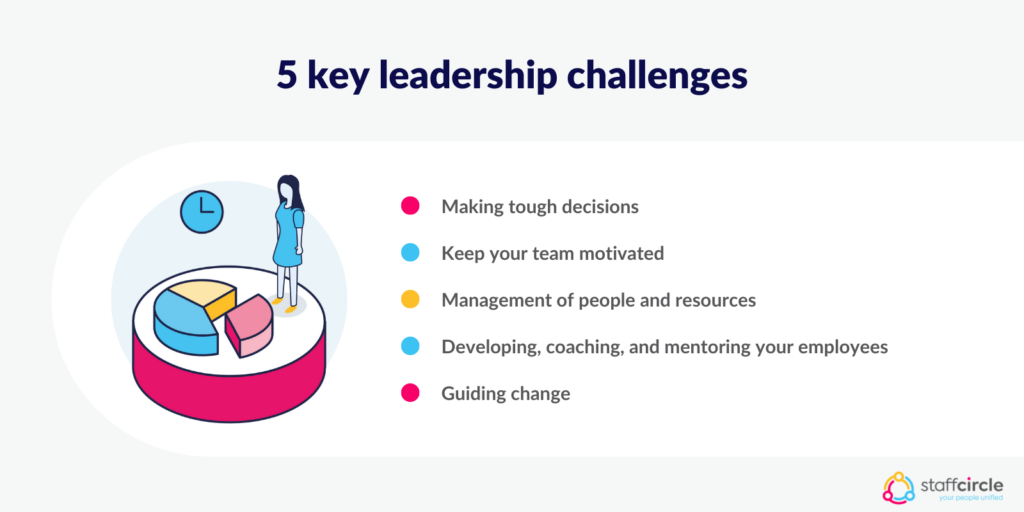
Here are some of the key leadership challenges that test the abilities of leaders.
Making tough decisions
Few managers like conflict, but making tough decisions is sometimes necessary in order to make sure optimal business outcomes are achieved. Some leaders avoid making tough decisions by believing they are being considerate of others, aiming to be seen as being fair. However, the decision ultimately needs to be made, so this attitude only shifts the responsibility onto others, potentially delaying necessary action.
Great leaders overcome this challenge by understanding that tough decisions are best dealt with in the short term and not postponed just because they make them feel uncomfortable. The article in the Harvard Business Review, Leaders, Stop Avoiding Hard Decisions, observes:
“Among the thousands of decisions you and your fellow leaders make in any given week, some of them will not go as hoped. You better serve your people by modeling how to navigate that reality than by trying to convince them it can be avoided.”
By tackling tough decisions head-on, leaders help individuals and teams to build resilience and come together to find solutions to the problems they face.
Keep your team motivated
One of the guiding principles of effective leadership is keeping employees motivated, and this can be achieved by developing a strong sense of purpose. A sense of purpose begins with the company’s core values, which should go beyond the basic “what” of the company’s product or service and extend into the “why” it brings real value to the market.
Team motivation can be further strengthened in a variety of ways, from conducting team-building exercises to help each team member strengthen bonds with their colleagues, to implementing awards and recognition programs to celebrate success.
Management of people and resources
The role of a leader is oriented around knowing where the strengths and weaknesses of individuals lie and how this fits into the bigger picture. This requires leadership that understands when to delegate duties – and who to delegate them to – and how to effectively distribute resources so that each team member can best perform their role.
Empowering employees and listening to their problems allows managers to better understand what they can do to help, and dealing with conflict resolution makes sure teams aren’t hindered by poor working relationships. Great leaders can achieve this without the need to micromanage, driving resources where they need to be and encouraging autonomous decision-making.
Developing, coaching, and mentoring your employees
Numerous studies have indicated a strong link between coaching and employee satisfaction. Coaching and development can increase overall feelings of well-being. It improves an employee’s ability to deal with problems and helps them become more aware of their skills and what truly motivates them.
Nurturing and developing employee talent is one of the core leadership skills every manager and team leader should have. The challenge for many leaders is finding the time needed in a busy schedule to help team members develop their skills in a meaningful way. This challenge can be overcome by:
- Using a HR ‘people database’ to identify skilled employees who can serve as mentors who help others develop in their role
- Creating a Personal Development Plan (PDP) collaboratively with employees to give their career development clear and concise goals
- Encouraging employees to become problem solvers and adopt personal responsibility
- Providing access to free online resources or toolkits that employees can work through in their own time
- Making development a consistent talking point during regular one2one check-ins with employees
Guiding change
Guiding change means developing leadership skills that are capable of adjusting to new challenges on the fly. When something unpredictable happens, a great leader knows how to reassure individuals and teams and help them address issues before they become a problem.
It also means helping employees adapt to new changes in the workplace they might be initially resistant to. In order to do this effectively, leaders need to be capable of delivering a clear vision and strategy so that employees understand their short- and long-term goals. Fostering a “can do” mindset means employees will be adaptable to change thanks to the effective guidance of their team leaders and managers.
Challenges of Self: 6 Internal Leadership Challenges
In addition to the external challenges discussed above, business leaders and managers face a number of internal challenges that might negatively impact their performance and ability to lead.
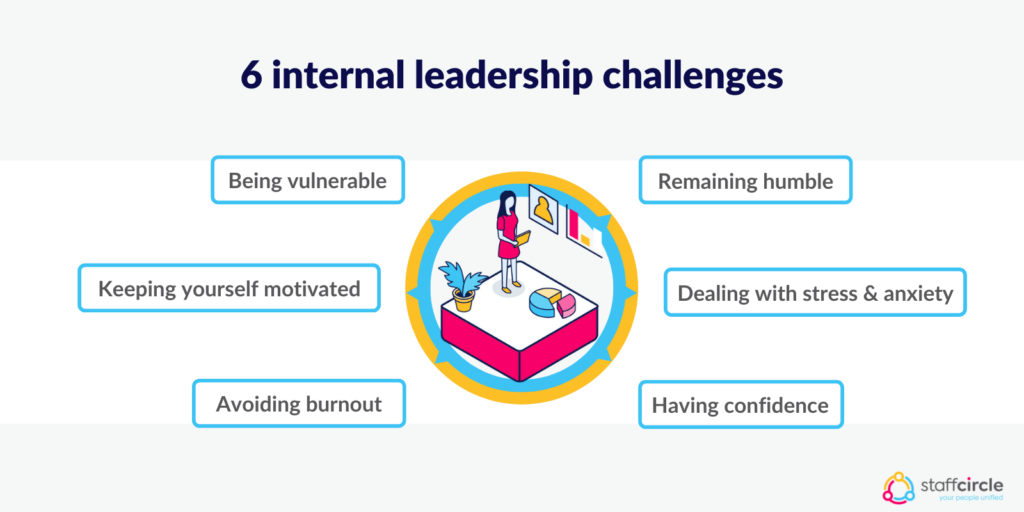
Let’s take a closer look at some of the main internal challenges leaders need to consider.
Remaining humble
The best leaders are those capable of displaying humility when appropriate. One of the major pitfalls inexperienced leaders face is becoming ‘out of touch’ with the workforce, which only serves to alienate employees and lay the groundwork for conflict.
Leaders can overcome this challenge by staying grounded, especially when the going gets rough. It’s vital to be honest and accept responsibility and ownership if a leadership strategy fails. Giving credit where credit is due is another way to demonstrate humility, and leadership recognition can foster a great employee relationship. Staying humble in a leadership position creates a more authentic work environment where honesty is valued.
Being vulnerable
The ability to demonstrate vulnerability is closely linked with the idea of humility. It shows a willingness to recognise that others may be more experienced in some matters, and asking for help when it’s required. Poor managers often refuse to acknowledge any weaknesses, and many employees recognise that this is simply a front.
In fact, showing vulnerability is key to building trust and strengthening bonds between leaders and employees. Vulnerable leaders are more capable of interacting with staff, which in turn opens up opportunities for them to do the same. When leaders open themselves up, they set the stage for constructive dialogue and a culture of transparency.
Having confidence
Displaying confidence in a way that inspires greater performance from those around you is a delicate balancing act. Overdo things, and you risk coming across as arrogant, so it’s important for leaders to temper displays of confidence with humility.
Strike the right tone, however, and a confident leader can have a positive impact on the workforce. Having confidence:
- Leads with the courage of your convictions and boost enthusiasm in the workplace
- Clarifies any messages that need communicating, avoiding unnecessary confusion and misunderstanding
- Enhances trust in the workplace by giving employees faith in their ability to lead
- Develops stronger relationships, with employees handling conflict with the understanding that their leaders are approachable
Confident leadership means understanding the value you bring to the organisation as a leader and instilling confidence in others to perform to the best of their abilities.
Keeping yourself motivated
While great leaders know how to motivate their employees, they should also understand what it takes to keep themselves motivated as well. A demotivated leader is in no position to help others enthuse about their roles, and if this is the case it needs to be addressed immediately.
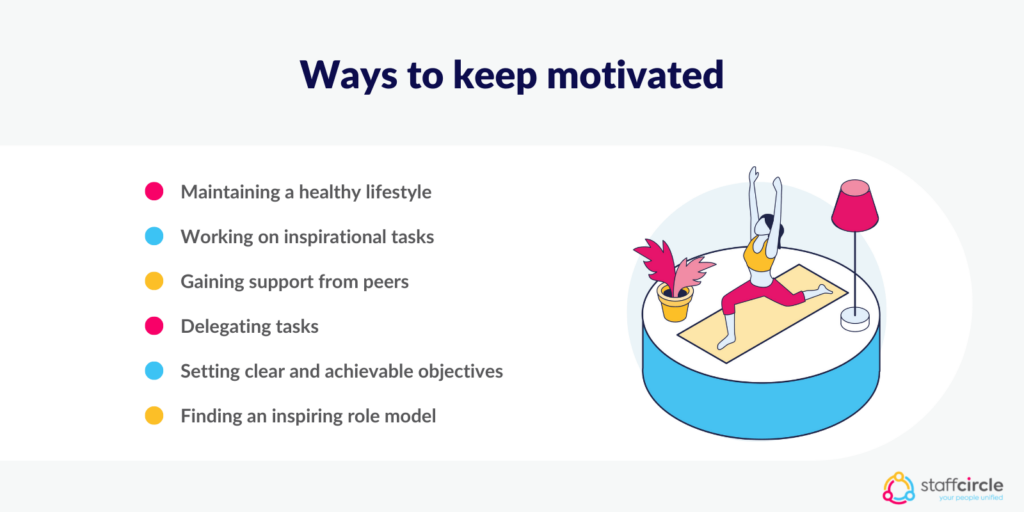
Leaders can keep themselves motivated by:
- Maintaining a healthy lifestyle
- Setting aside time in the week to work on tasks they find inspirational
- Gaining support from peers who can keep them on track
- Delegating tasks that could be better achieved by another member of the team
- Setting clear and achievable objectives to help them focus on a day-to-day basis
- Finding an inspiring role model to help guide their leadership skills
Avoiding burnout
Burnout can be caused by a range of factors and is characterised by depleted energy levels, low moods, decreased confidence or self-assurance and a lack of motivation. It can be caused by anything from overwork to encountering resistance from others in the organisation.
In order to overcome the challenges associated with burnout – and prevent it from happening in the first place – leaders can adopt a number of strategies. Taking the time to unplug from devices and take a short walk can help leaders revitalise their energy levels. Communicating any feelings of overwork to the HR department or superiors can lay the groundwork for changing a schedule so that burnout can be avoided.
Ultimately, resilient leaders who lead with empathy are best positioned to avoid burnout themselves. By understanding what is required for a healthy work-life balance, they can create a work environment that emphasises quality mental health and well-being.
Dealing with stress and anxiety
Leadership can be a high-pressure role, especially when project deadlines loom, so great leaders need to adopt a mindset that minimises stress when the going gets tough. Successfully dealing with stress and anxiety is a key method to avoiding burnout.
Leaders can overcome the challenges associated with stress and anxiety by:
- Asking for help and support and sharing your inner struggles with those who can offer guidance
- Encouraging open communication about stress and anxiety, sharing coping strategies with others who might be struggling to cope
- Acknowledge and accept anxiety instead of internalising it and allowing it to transform into anger and resentment
How can I overcome leadership challenges?
We’ve covered a broad range of potential challenges every leader faces, as well as the strategies you can use to overcome them.
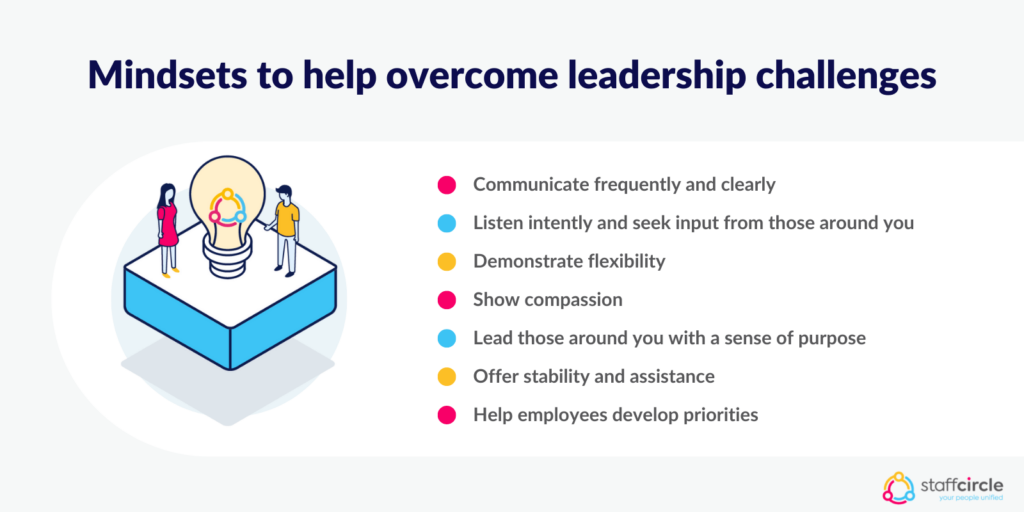
On a more general note, when struggling with leadership challenges, consider the following mindsets to help overcome them:
- Communicate frequently and clearly with your teams and employees
- Listen intently and seek input from those around you
- Demonstrate flexibility
- Show compassion
- Lead those around you with a sense of purpose
- Offer stability and assistance
- Help employees develop priorities
These rules of thumb will give you the confidence to tackle any challenges head-on while creating the best possible work environment for your employees.
In Summary
Leadership challenges come in many forms, but with the right mindset and tools in place, great leaders are able to overcome them and triumph. This guide should help your organisation develop leaders who are capable of tackling external and internal challenges, allowing them to focus on what matters the most and foster a workforce of high-performing employees.





